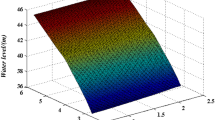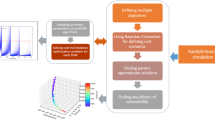Abstract
Design flood via flood frequency analysis provides basic information for designing hydraulic structures. Quantification of uncertainty in flood frequency analysis has become an important issue during the past three decades. However, few studies have considered practical procedures for selecting a single design flood in the uncertainty range. Cost-benefit analysis can be incorporated to select a single design flood by calculating the optimal value in the total expected cost function. In particular, in this study, the relationship between conventional flood frequency analysis and cost-benefit analysis is addressed. Additionally, the parameter uncertainty is quantified by the Metropolis-Hastings algorithm to find the optimal design floods considering parameter uncertainty. The annual maximum (AM) series and partial duration (PD) series were used to identify the effect of various types of data. The optimal design floods obtained by the cost-benefit analysis considering parameter uncertainty were systematically larger than the design flood obtained by the conventional flood frequency analysis. Regarding the types of data, the generalized Pareto distribution (GPD) had the largest values in all return periods, while the Gumbel distribution had the smallest values in all cases.









Similar content being viewed by others
Data Availability
All authors made sure that all data and materials support our published claims and comply with field standards.
References
Ahilan S, O’Sullivan JJ, Bruen M (2012) Influences of flood frequency distributions in Irish river catchments. Hydrol Earth Syst Sci 16(4):1137–1150
Behrouz M, Alimohammadi S (2016) Risk-based design of flood control systems considering multiple dependent uncertainties. Water Resour Manag 30:4529–4558
Bezak N, Brilly M, Sraj M (2014) Comparison between the peaks-over-threshold method and the annual maximum method for flood frequency analysis. Hydrol Sci J 59(5):959–977
Botto A, Ganora D, Laio F, Claps P (2014) Uncertainty compliant design flood estimation. Water Resour Res 50:4242–4253
Cunnane C (1973) A particular comparison of annual maxima and partial duration series methods of flood frequency prediction. J Hydrol 18(3–4):257–271
Davis D, Faber BA, Stedinger JR (2008) USACE experience in implementing risk analysis for flood damage reduction projects. J Contemp Water Res Educ 140(1):3–14
De Michele C, Rosso R (2001) Uncertainty assessment of regionalized flood frequency estimates. J Hydrol Eng 6(6):453–459
Dieperink C, Hegger DLT, Bakker MHN, Kundzewicz ZW, Green C, Driessen PPJ (2016) Recurrent governance challenges in the implementation andalignment of flood risk management strategies: a review. Water Resources Management 30(13):4467–4481
Gamerman D (1997) Markov chain Monte Carlo-stochastic simulation for Bayesian inference. Chapman&Hall, London, UK
Ganoulis J (2003) Risk-based floodplain management: a case study from Greece. Int J River Manag 1(1):41–47
Gelman A, Rubin DB (1992) Inference from iterative simulation using multiple sequences. Stat Sci 7:457–511
Geweke J (1992) Evaluating the accuracy of sampling-based approaches to the calculation of posterior moments. In: Bernardo JM, Berger J, Dawid AP, Smith AFM (eds) Bayesian statistics 4. Oxford University Press, Oxford, UK, pp 169–193
Irvine KN, Waylen PR (1986) Partial series analysis of high flows in Canadian rivers. Can Water Resour J 11(2):83–91
Kuczera G (1999) Comprehensive at-site flood frequency analysis using Monte Carlo Bayesian inference. Water Resour Res 35(5):1551–1557
Lang M, Ouarda TBMJ, Bobee B (1999) Towards operational guidelines for over-threshold modeling. J Hydrol 225(3–4):103–117
Lee KS, Kim SU (2008) Identification of uncertainty in low flow frequency analysis using Bayesian MCMC method. Hydrol Process 22:1949–1964
Lee CE, Kim SU, Lee S (2014) Time-dependent reliability analysis using Bayesian MCMC on the reduction of reservoir storage by sedimentation. Stoch Env Res Risk A 28:639–654
Madsen H, Ramussen PF, Rosbjerg D (1997) Comparison of annual maximum series and partial duration series methods for modeling extreme hydrologic events. 1: at-site modeling. Water Resour Res 33(4):747–757
Menoni S, Molinari D, Ballio F, Minucci G, Mejri O, Atun F, Bernni N, Pandolfo C (2016) Flood damage: a model for consistent, complete and multipurpose scenarios. Nat Hazards Earth Syst Sci 16:2783–2797
Merz B, Thieken AH (2005) Separating natural and epistemic uncertainty in flood frequency analysis. J Hydrol 309(1–4):114–132
Metropolis N, Rosenbluth AW, Teller AH, Teller E (1953) Equations of state calculations by fast computing machines. J Chem Phys 21:1087–1092
Nadarajah S, Ali MM (2008) Pareto random variables for hydrological modeling. Water Resour Manag 22:1381–1393
Nadarajah S, Shiau JT (2005) Analysis of extreme flood events for the Pachang River, Taiwan. Water Resour Manag 19:363–374
Önöz B, Bayazit M (1995) Best-fit distributions of largest available flood samples. J Hydrol 167(1–4):195–208
Paprotny D, Vousdoukas MI, Morales-Napoles O, Jonkman SN, Feyen L (2020) Pan-European hydrodynamic models and their ability to identify compound floods. Nat Hazards 101:933–957
Qi W, Zhang C, Fu G, Zhou H (2016) Imprecise probabilistic estimation of design floods with epistemic uncertainties. Water Resour Res 52:4823–4844
Raftery AE, Lewis S (1992) How many iterations in the Gibbs sampler? In: Bernardo JM, Berger J, Dawid AP, Smith AFM (eds) Bayesian statistics 4. Oxford University Press, Oxford, UK pp, pp 763–773
Rasmussen PF, Rosbjerg D (1991) Evaluation of risk concepts in partial duration series. SERRA 5:1–16
Raso L, Weijs SV, Werner M (2018) Balancing costs and benefits in selecting new information: efficient monitoring using deterministic hydro-economic models. Water Resour Manag 32:339–357
Ribatet M, Sauquet E, Gresillon J-M, Ouarda TBMJ (2007) A regional Bayesian POT model for flood frequency analysis. SERRA 21:327–339
Röthlisberger V, Zischg AP, Keiler MA (2018) Comparison of building value models for flood risk analysis. Nat Hazards Earth Syst Sci 18:2431–2453
Salas JD, Heo JH, Lee DJ, Burlando P (2013) Quantifying the uncertainty of return period and risk in hydrologic design. J Hydrol Eng 18(5):518–526
Salman AM, Li Y (2018) Flood risk assessment, future trend modeling, and risk communication: a review of ongoing research. Nat Hazards Rev 19(3):1–54
Stedinger JR (1983) Design events with specified flood risk. Water Resour Res 19(2):511–522
US Army Corps of Engineers (1996) Risk-based analysis for flood damage reduction studies; Eng. Manual 1110–2-1619; Washington D.C.
Wood EF, Rodriguez-Iturbe I (1975) Bayesian inference and decision making for extreme hydrologic events. Water Resour Res 11(4):533–542
Xie A, Liu P, Guo S, Zhang X, Jiang H, Yang G (2018) Optimal design of seasonal flood limited water levels by jointing operation of the reservoir and floodplains. Water Resour Manag 32:179–193
Xu W, Jiang C, Yan L, Li L, Liu S (2018) An adaptive Metropolis-Hastings optimization algorithm of Bayesian estimation in non-stationary flood frequency analysis. Water Resour Manag 32:1343–1366
Acknowledgments
This study has been worked with Basic Science Research Program through the National Research Foundation of Korea funded by the Ministry of Education (2018R1D1A1B07040409).
Funding
This study has been worked with Basic Science Research Program through the National Research Foundation of Korea funded by the Ministry of Education (2018R1D1A1B07040409).
Author information
Authors and Affiliations
Contributions
Sang Ug Kim performed frequency analysis with cost-benefit strategy and prepared this manuscript. Cheol-Eung Lee gave an advice on the direction of this study.
Corresponding author
Ethics declarations
Conflict of Interest
None.
Ethical Approval
All authors kept the ‘Ethical Responsibilities of Authors’.
Consent to Participate
All authors gave explicit consent to participate in this study.
Consent to Publish
All authors gave explicit consent to publish this manuscript.
Competing Interests
Not applicable.
Additional information
Publisher’s Note
Springer Nature remains neutral with regard to jurisdictional claims in published maps and institutional affiliations.
Rights and permissions
About this article
Cite this article
Kim, S.U., Lee, CE. Incorporation of Cost-Benefit Analysis Considering Epistemic Uncertainty for Calculating the Optimal Design Flood. Water Resour Manage 35, 757–774 (2021). https://doi.org/10.1007/s11269-021-02764-z
Received:
Accepted:
Published:
Issue Date:
DOI: https://doi.org/10.1007/s11269-021-02764-z




